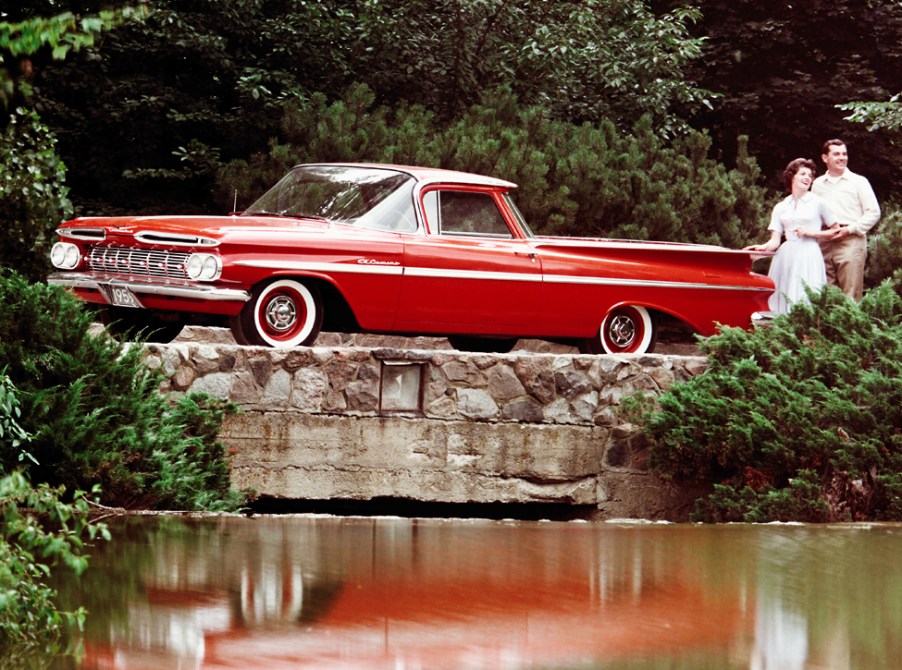
The First Outrageous Chevy El Caminos
One of the most outrageous American cars from the 1950s in a decade of outrageous designs, was the 1959 Chevy El Camino. Not only did it have the bat wing fins, crazy cats-eye taillights, and nostrils in the hood, but it was GM’s first car/truck. Wrapping windshield, flat top, extreme sculpturing, the first El Camino was a study in magnificent extremes.
Ford was first in the car/truck parade with the 1957 Ranchero, but you could argue that Chevy had its own car/truck back in the late-1930s when it offered a truck bed attached to the trunk of Chevy coupes. It wasn’t pretty, but trucks weren’t supposed to be. With the Ranchero and El Camino, that all changed.

What helped to make the case for producing the El Camino and get the bean counters to say yes was that Chevy tooled up a two-door station wagon. By this time two-door wagons were not sexy Nomads Chevy built from 1955-1957. Instead, they were considered budget wagons for those who could not afford a new four-door Brookwood or Impala wagon.
Here’s Why The El Camino Was Approved
Because there was wagon tooling for, let’s say 70% of what it took to build an El Camino, the numbers indicated the 30% more was worth the investment. Even in the 1950s it had to pass the accountants’ scrutiny before development could begin. And some of that two-door tooling could be used for the four-door wagons, too. Common tooling breeds cheaper production costs.
The El Camino would be a two-door wagon with part of the roof chopped off. A stamped steel bed floor was laid into the body behind the front seat. This was the first Chevy pickup to have a steel floor instead of wood.
With die-cast chrome moldings covering the top of the bed to hide the cuts and pinch welds it was an easy transformation. Also, Chevy could list the price lower because there were no upholstery concerns in back like in a station wagon. No seat, door panels, finished floor, and extra trim to deal with.
First Year Sold Well
The first year of Ranchero sales saw over 21,000 sold. This gave GM a window into what it might expect for a similar Chevy version. In 1958 Ranchero saw a drop to just under 10,000 units. Was this the beginning of the end?

It was too late to stop, as Chevy marched on with plans to launch its own utility truck for 1959. It even used the station wagon’s tailgate with a big chrome plate to hide where the outside handle for the wagon back window rotated. If you didn’t need to haul around passengers, the El Camino was lighter, cheaper, and some would say much more stylish than a comparable wagon.
Any option available on the regular Chevy line could be ordered. Even Impala trim and air conditioning could be added. The same could be done for engines. Power ranged from the standard “Stovebolt” straight-six to two versions of the small block V8. Even the 348 ci W big block engine could be had in either the 315 hp four-barrel version or the 335 hp Super Turbo-Thrust 348.
Options Galore!
Three-speed granny shift manuals, Powerglide and Turboglide automatics, and a floor-mounted four-speed T-10 were available for all of your transmission wants and needs.

For 1959 the El Camino sold over 22,000 units. With a facelift for 1960 the basically same car sold over 14,000. A drop for sure, but not the reason the El Camino was dropped after 1960. That reason would be because there was not a two-door wagon tooled for the all-new 1961 full-size Chevys. Without factoring in the two-door wagon costs into the bottom line, it didn’t make business sense to make them.
The El Camino Returns

When Chevy debuted its all-new line of midsize Chevy Chevelles in 1964, it offered a two-door wagon. Guess, what? That year the El Camino returned. It saw continuous production through 1987. Even after that the Australian GM division of Holden continued making its version of the El Camino, called a “Ute,” until GM stopped all production in Australia in 2016.



